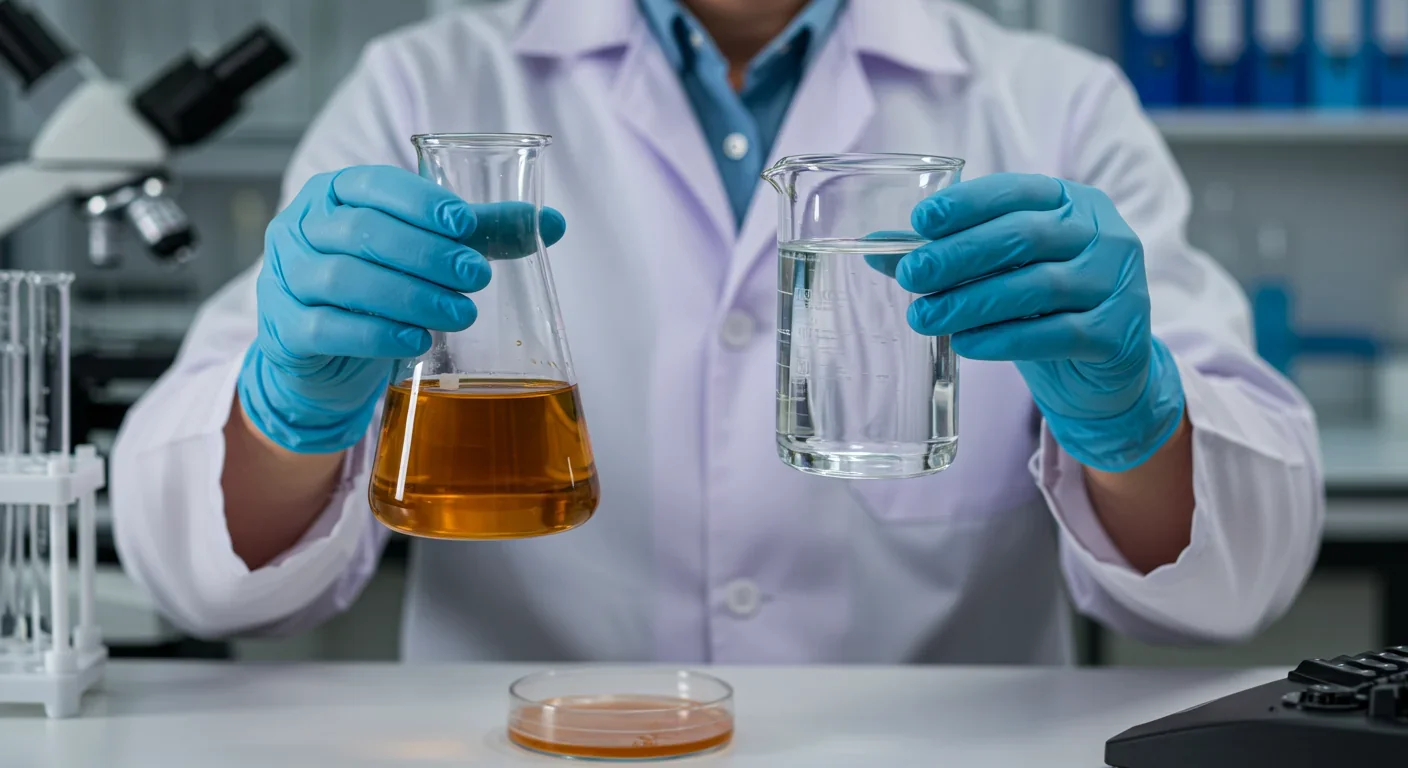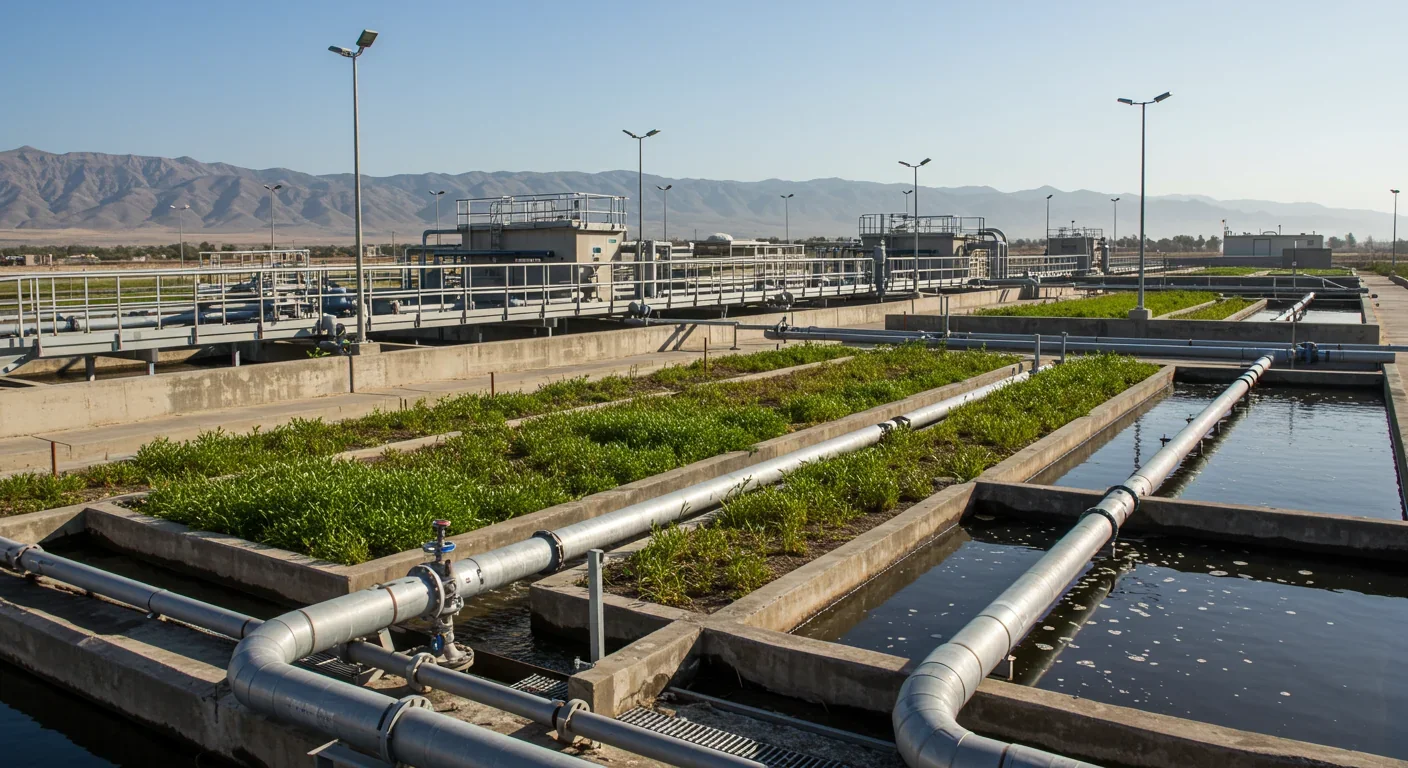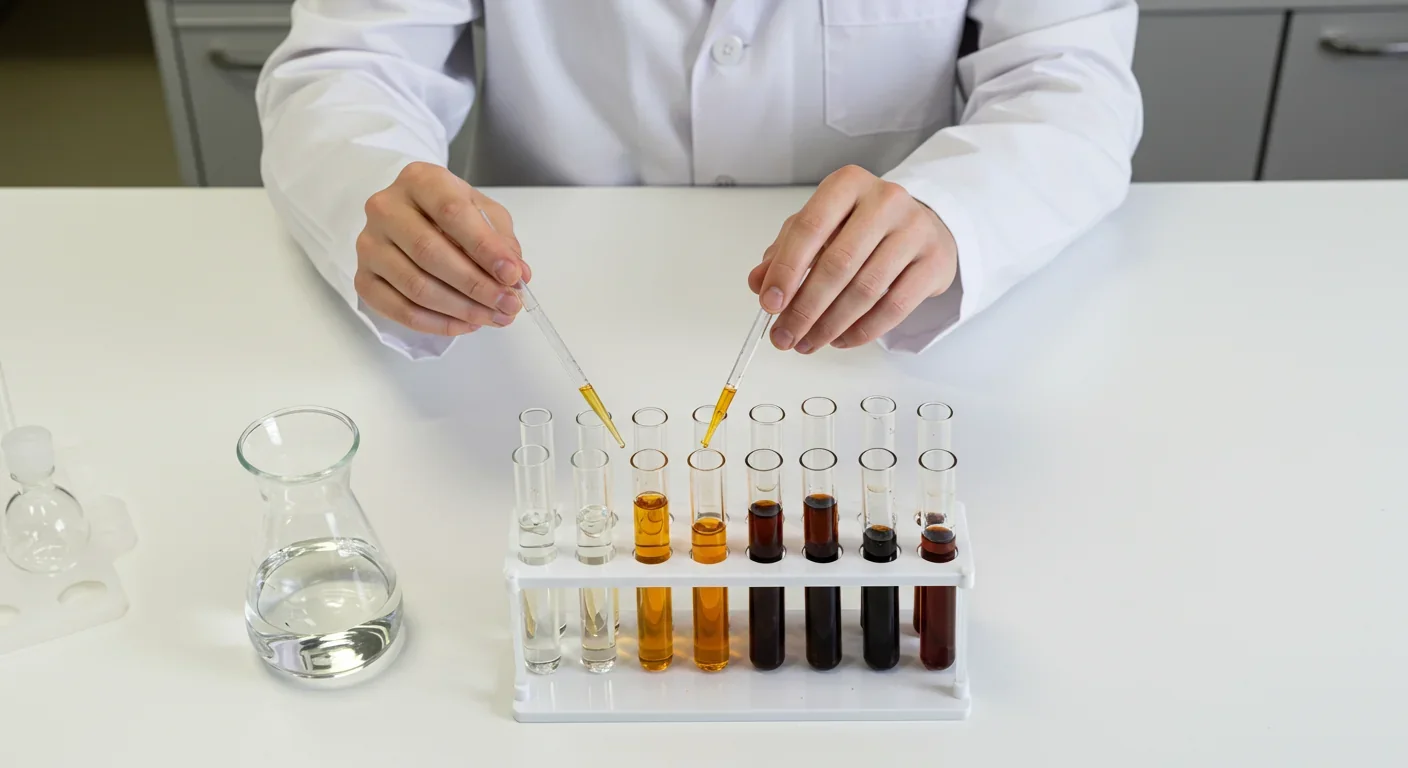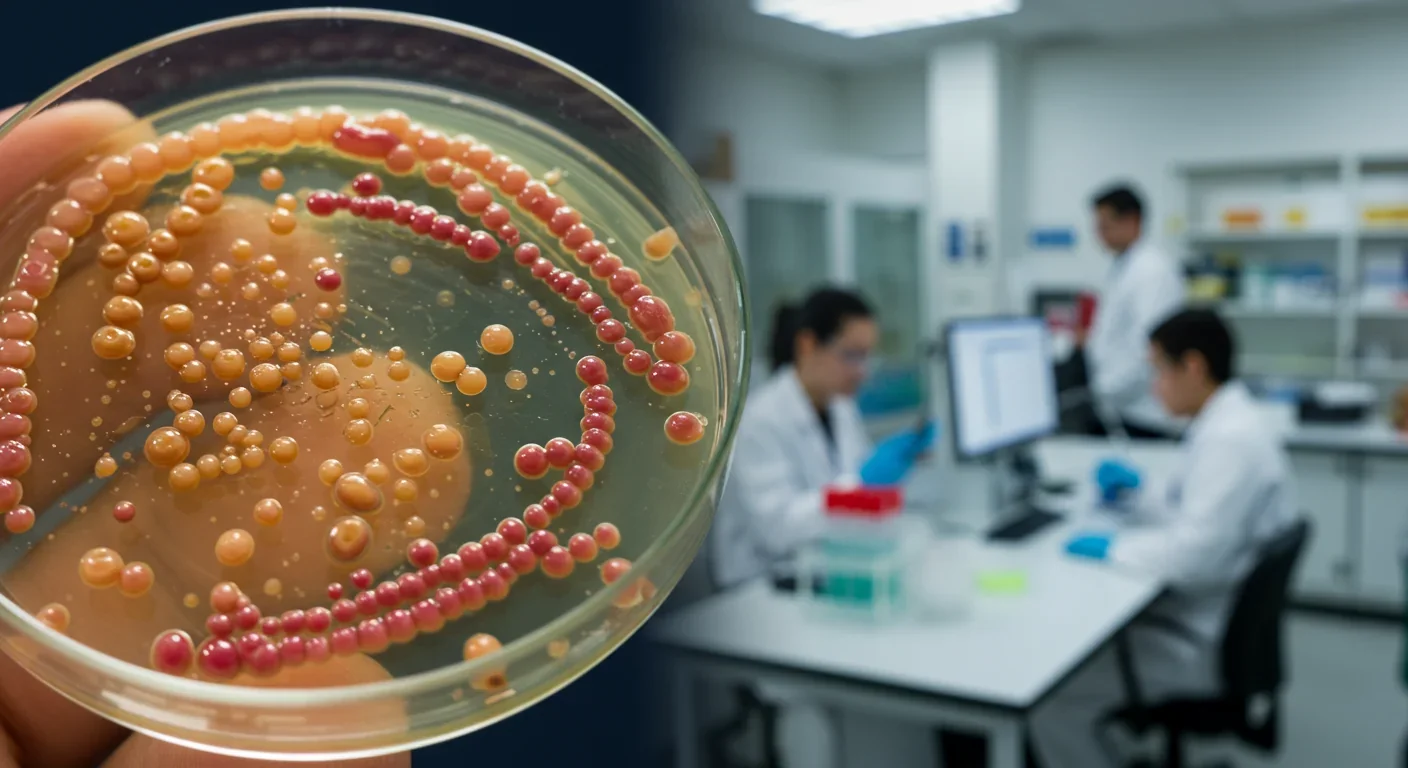Kelp Forests and Climate Change: Marine Permaculture Guide

TL;DR: By 2030, billions may drink water cleaned by bacteria that transform toxic metals into harmless minerals at a fraction of conventional treatment costs. Pilot projects in China, Brazil, and Colorado have already demonstrated 90-99% removal of lead, cadmium, uranium, and mercury using microbes that precipitate metals as stable crystals. This biomineralization revolution could decentralize water treatment, slash costs by 20-30%, and turn contamination into recoverable resources—but faces challenges including slow reaction rates, regulatory hurdles, and the need to scale from liters to millions of cubic meters.

By 2030, billions of people may drink water cleaned not by chemicals or electricity-hungry filters, but by bacteria, algae, and fungi that transform dissolved poisons into harmless minerals—and sometimes into nano-gold. This isn't science fiction. In China's smelting zones, Brazil's mining valleys, and Colorado's contaminated aquifers, researchers have already deployed nature's most ingenious metallurgists: microorganisms that can pull cadmium, uranium, and mercury from water, locking them into stable crystals at a fraction of the cost of conventional treatment. Welcome to the age of biomineralization—where evolution's 3.5-billion-year R&D program is finally going industrial.
In 2025, a team working with acidic smelting wastewater in Hunan Province, China, achieved what traditional chemistry struggles to do: they removed 99.78% of zinc, 99.09% of cadmium, 98.35% of copper, and 92.26% of lead—without adding a single chemical precipitant. Their secret? A carefully orchestrated consortium of phosphate-solubilizing bacteria (PSB) and urease-producing bacteria (UPB) that worked in concert to create dense, spherical carbonate–phosphate minerals, each one a tiny vault encasing toxic metals in an inert crystalline matrix.
What makes this different from every water treatment plant you've ever seen is that the microbes do all the heavy lifting. Feed them soluble starch and urea—dirt-cheap agricultural byproducts—and they raise the pH, liberate phosphate ions, and generate carbonate, all while precipitating dissolved metals into a form so stable it can be landfilled or even mined for metal recovery. The process runs at 30 °C, requires no external pH adjustment, and produces a dense sludge that settles rapidly, making it ideal for retrofit into existing wastewater infrastructure.
Meanwhile, 10,000 kilometers away in Rifle, Colorado, researchers injected acetate into uranium-contaminated groundwater and watched as populations of Geobacter metallireducens bloomed underground. Within nine days, dissolved vanadium(V) concentrations began to drop; by 39 days, levels had fallen below the regulatory threshold of 6 µM—a reduction achieved not by pumping and treating aboveground, but by coaxing native bacteria to reduce soluble, mobile U(VI) and V(V) into insoluble oxides that precipitate in place. The aquifer, in effect, healed itself.
These aren't isolated lab curiosities. They're pilot-scale demonstrations of a principle that could rewrite the economics of water remediation: letting biology do what chemistry does expensively, slowly, or not at all.
Biomineralization isn't new—it's how Earth made most of its mineral wealth. Stromatolites, the layered rock formations built by cyanobacteria over billions of years, are testament to microbes' ability to precipitate calcium carbonate. Banded iron formations, some of the planet's oldest rocks, record the work of ancient iron-oxidizing bacteria. Even gold nuggets may owe their existence to microbial metallurgy: researchers have discovered that Cupriavidus metallidurans, a bacterium thriving in toxic gold-bearing solutions, precipitates metallic gold nanoparticles as a detoxification mechanism. In laboratory experiments, this organism transforms gold(III) chloride—a compound lethal to most life—into glittering nano-gold using a specialized Au-specific gene cluster.
Humanity has long borrowed from biology to clean up its messes. The Romans used willows to dewater swamps; Victorian-era Londoners relied on slow sand filters—essentially microbial biofilms—to purify Thames water. But the 20th century's love affair with chemical engineering sidelined these approaches. Why wait for bacteria to reduce chromium when you can dump sodium metabisulfite into a tank and watch it happen in minutes?
The answer is cost, energy, and waste. Conventional heavy-metal removal—chemical precipitation, ion exchange, reverse osmosis—is expensive, energy-intensive, and generates hazardous sludge. A kilogram of synthetic ion-exchange resin can cost ten times more than an equivalent mass of biosorbent derived from agricultural waste. Reverse osmosis membranes foul, require high pressure, and concentrate contaminants into brines that still need disposal. Chemical precipitation produces voluminous sludges that must be dewatered, stabilized, and landfilled.
Biology offers a different trade-off: lower capital cost, minimal energy input, and the possibility of recovering metals for reuse. The catch? Slower reaction rates, sensitivity to environmental conditions, and the need to understand—and sometimes engineer—complex microbial ecosystems. But as climate imperatives push us toward low-carbon solutions and as contamination spreads to regions too poor for high-tech fixes, the biological option is moving from fringe to frontier.

At the molecular level, biomineralization is a dance of electrons, ions, and enzymes. Microorganisms remove heavy metals through several overlapping mechanisms:
Biosorption: Microbial cell walls are studded with functional groups—carboxyl, hydroxyl, phosphate, amine—that act like molecular Velcro for metal cations. Lead, cadmium, and copper ions stick to these sites via electrostatic attraction and ion exchange. This is a passive, metabolically independent process; even dead cells can biosorb metals. In controlled experiments, dead Bacillus sphaericus cells removed 13–20% more chromium than living ones, because metabolic activity wasn't diverting resources. This opens the door to using low-cost, non-living biomass—seaweed, agricultural residues, brewery waste—as disposable biosorbents.
Enzymatic Reduction: Many bacteria can use oxidized metals as electron acceptors in anaerobic respiration. Geobacter species, for instance, oxidize acetate or other organic acids and shuttle electrons to external metals via conductive protein nanowires called pili. G. sulfurreducens reduces U(VI) to U(IV), which precipitates as uraninite (UO₂); it reduces Cr(VI) to Cr(III), dramatically lowering toxicity and mobility. G. metallireducens goes further, reducing Fe(III), Mn(IV), V(V), and even Hg(II) to Hg(0), which volatilizes and escapes the water column—a double-edged sword, since airborne mercury poses its own risks.
The beauty of these organisms lies in their versatility. G. uraniireducens lacks conductive pili but compensates by secreting riboflavin, a soluble electron shuttle that ferries electrons from the cell to distant iron oxides or uranium ions. This extracellular electron transport (EET) system can be enhanced in the field: at contaminated sites, injecting acetate stimulates native Geobacter populations, accelerating metal reduction without the need to culture and inject exotic strains.
Biomineralization via Metabolic Byproducts: Urease-producing bacteria hydrolyze urea into ammonia and carbon dioxide; the ammonia raises pH while CO₂ dissolves to form carbonate ions. In the presence of calcium or other divalent cations, carbonate precipitates as calcite (CaCO₃), co-precipitating heavy metals within the crystal lattice. Phosphate-solubilizing bacteria (PSB) liberate orthophosphate from insoluble minerals or organic matter; this phosphate then precipitates metals as stable phosphates—leadapatite, cadmium phosphate—that resist leaching even under acidic conditions.
The Chinese smelting-wastewater study exploited this synergy. PSB and UPB, working together, raised pH from 4.92 to 8.33, boosted phosphate concentration to 7.5 mg/L, and generated carbonate ions—all while consuming nothing more exotic than starch and urea. The result was a dense, spherical precipitate: a composite carbonate–phosphate phase with embedded copper, zinc, cadmium, and lead. SEM-EDS imaging revealed that the metals were distributed uniformly throughout the mineral matrix, not merely adsorbed on the surface. XRD analysis confirmed crystalline carbonate and phosphate phases, suggesting long-term stability.
Sulfate Reduction and Metal Sulfide Precipitation: Sulfate-reducing bacteria (SRB) are the workhorses of acid mine drainage (AMD) remediation. These anaerobes oxidize organic carbon (acetate, lactate, even rice bran) and reduce sulfate (SO₄²⁻) to sulfide (S²⁻). Sulfide ions immediately react with dissolved metals—iron, zinc, cadmium, lead, copper—forming insoluble metal sulfides (FeS, ZnS, CdS, PbS, CuS) that precipitate as black sludge. In pilot-scale passive bioreactors at the Vale Mine in Brazil, SRB-driven systems achieved 97% iron removal and 92% cadmium removal over a 120-day hydraulic retention period, treating real mine effluent at a flow rate of 1 m³/day.
These sulfide minerals are remarkably stable under anaerobic conditions and can even be recovered for metal recycling. The challenge is keeping the system anaerobic; exposure to oxygen re-oxidizes sulfides to sulfate, releasing metals back into solution.
Biomineralization is not just a technical fix—it's a socioeconomic pivot that could redefine who can afford clean water and where industrial activity is sustainable.
Decentralizing Water Treatment: Conventional treatment plants are monuments of concrete, steel, and electricity. They require trained operators, reliable power grids, and supply chains for chemicals. Biomineralization, by contrast, can run in passive bioreactors—essentially buried tanks of wood chips, straw, or rice bran inoculated with SRB—that require no external energy and minimal maintenance. This makes them ideal for remote mining sites, rural communities, and low-income countries where conventional infrastructure is unaffordable.
A 2024 economic assessment estimated that SRB-based AMD treatment costs 20% less in capital and 30% less in operating expenditure than chemical precipitation. For a small mining cooperative in Peru or Zambia, this could mean the difference between sustainable operation and abandonment.
Job Market Transformation: The rise of biotech-driven remediation will create demand for microbial ecologists, bioprocess engineers, and field technicians trained in microbiology—roles that didn't exist in the traditional water-treatment labor market. Universities in mining-dependent regions—Montana, Queensland, Northern Chile—are beginning to offer specialized programs in environmental microbiology and bioremediation engineering.
At the same time, chemical suppliers and equipment manufacturers reliant on conventional technologies may face disruption. The shift could mirror the impact of renewable energy on fossil fuel industries: gradual at first, then accelerating as costs fall and regulatory pressures mount.
Cultural and Ethical Shifts: Biomineralization embodies a philosophical shift from domination to partnership with nature. Instead of engineering solutions against biology—biocides, high-pH shocks, oxidative blasts—we're learning to work with microbial metabolisms honed over eons. This resonates with indigenous and ecological worldviews that emphasize reciprocity and stewardship.
But it also raises biosafety questions. Cupriavidus metallidurans, champion of gold and heavy-metal resistance, has been documented as an opportunistic human pathogen; a 74-year-old man was infected with this organism. Deploying it at scale in industrial bioreactors requires careful containment and monitoring. The possibility of horizontal gene transfer—resistance genes jumping from engineered or enriched strains to environmental bacteria—demands robust risk assessment.
Heavy-metal contamination is a silent pandemic. Arsenic poisons groundwater across Bangladesh, India, and Cambodia, affecting over 200 million people. Lead leaches from aging pipes in Flint, Michigan, and thousands of other cities. Mercury from artisanal gold mining contaminates rivers in the Amazon and Southeast Asia. Cadmium from phosphate fertilizers accumulates in rice paddies across Asia. Uranium from Cold War-era processing sites leaches into aquifers from Hanford, Washington, to Kazakhstan.
Conventional solutions are piecemeal and expensive. Biomineralization offers a scalable, low-cost toolkit:
Private Wells: In the U.S., 15 million households rely on private wells exempt from EPA oversight. These wells are vulnerable to heavy metals from natural mineral deposits, agricultural runoff, and aging infrastructure. A simple biofilter—layered biochar inoculated with metal-reducing bacteria—could provide point-of-use treatment for pennies per liter.
Constructed Wetlands: An 18-month field trial in China used constructed wetlands modified with biochar, natural zeolite, and granular activated carbon to treat municipal wastewater. The system removed 91% of bulk organics, 96% of zinc, 92% of copper, 91% of nickel, 86% of chromium, and 83% of iron. Hydraulic retention times were dramatically lower than conventional wetlands, making the approach viable even in land-scarce urban settings.
Phytoremediation + Biomineralization: Combining metal-hyperaccumulating plants (Brassica juncea, Jatropha curcas) with rhizosphere bacteria creates a dual-benefit system. The plants extract metals from soil into their shoots; rhizosphere microbes mineralize metals in the root zone, reducing leaching. Harvested biomass can be pyrolyzed to produce biofuels, with metals concentrated in the ash for recovery. A pilot project on mine tailings in Hunan Province integrated bioweathering by microbes with planting of biofuel crops, transforming sterile, toxic waste rock into a stable soil matrix capable of supporting agriculture within three growing seasons.
Energy Recovery: Some Geobacter species generate electricity while reducing metals, enabling microbial fuel cells (MFCs) that simultaneously remediate uranium or chromium and produce power. While current densities are still too low for grid-scale generation, MFCs could offset the operating cost of remote bioreactors.
Metal Recovery and Circular Economy: The mineralized byproducts of biomineralization aren't just waste—they're low-grade ore. Metal sulfides precipitated by SRB can be smelted to recover copper, zinc, or lead. Gold nanoparticles formed by C. metallidurans could be harvested from tailings leachate. This closes the loop: contamination becomes feedstock.

No technology is without trade-offs, and biomineralization's challenges are real:
Slow Kinetics: Microbes work on biological time. While chemical precipitation can clear metals in minutes, biosorption and enzymatic reduction can take hours to weeks. For high-throughput industrial applications, this may require prohibitively large reactor volumes.
Environmental Sensitivity: Microbial activity is exquisitely sensitive to pH, temperature, nutrient availability, and toxic shocks. A pH drop from 7 to 5 can halve biosorption capacity. A cold snap can stall SRB activity. Co-contaminants—cyanide, organic solvents—can poison microbial consortia. Maintaining stable performance in real-world effluents, which vary minute-to-minute, demands robust process control or highly resilient microbial communities.
Scaling Uncertainties: Many of the studies cited here are bench-scale (liters) or pilot-scale (cubic meters). Scaling to municipal or industrial volumes (thousands of cubic meters per day) introduces new challenges: mixing inefficiencies, short-circuiting, biofilm clogging, and the need for continuous inoculation or biomass harvesting.
Regulatory Hurdles: Drinking water treatment in the U.S. is governed by the Safe Drinking Water Act, enforced by the EPA through National Primary Drinking Water Regulations (NPDWRs). Before biomineralization can be approved for potable water, utilities must demonstrate consistent compliance with Maximum Contaminant Levels (MCLs) for dozens of analytes, often requiring years of monitoring data. Industrial wastewater faces fewer barriers, but even there, discharge permits set strict limits on effluent quality.
Unintended Consequences: Volatile mercury (Hg⁰) produced by Geobacter may escape to the atmosphere, contributing to global mercury deposition. Metal sulfides, if exposed to oxygen during disposal, can re-oxidize and release metals. The stability of carbonate–phosphate co-precipitates under variable environmental conditions—seasonal pH swings, microbial activity in landfills—remains poorly characterized. A 2025 study in Hunan called for long-term leaching tests to confirm that the mineralized products won't remobilize metals decades hence.
Equity and Access: If biomineralization technology is patented, licensed, and commodified, it risks becoming another tool available only to wealthy nations and corporations. Open-source bioprocess designs, community-scale training programs, and public-sector investment are essential to ensure that the benefits reach those who need them most: marginalized communities with contaminated wells, artisanal miners working toxic streams, and nations where water crises are existential.
The biomineralization revolution is unfolding unevenly across the globe, shaped by local priorities, resources, and regulatory cultures.
China: Facing acute soil and water contamination from decades of rapid industrialization, China is investing heavily in bioremediation R&D. The Hunan smelting-wastewater project exemplifies this: government-funded, published open-access, and explicitly designed for retrofit into existing plants. China's regulatory environment allows faster deployment of novel technologies, but transparency and independent monitoring lag behind Western norms.
United States: Federal agencies (EPA, DOE) have funded Geobacter-based uranium bioremediation at Superfund sites for two decades, but translation to commercial practice has been slow. Regulatory caution, liability concerns, and cheap fossil energy reduce the economic pressure to adopt biological alternatives. Private-sector interest is growing, however, driven by ESG (environmental, social, governance) commitments and the rising cost of hazardous waste disposal.
Brazil and South America: Mining-dependent economies with limited public budgets are natural early adopters. The Vale Mine bioreactor pilot demonstrates that passive, low-maintenance systems can function in remote locations. Indigenous communities, historically excluded from industrial decision-making, are beginning to demand a voice in remediation strategies, sometimes favoring biological approaches aligned with traditional ecological knowledge.
Europe: The EU's precautionary principle and strict chemical regulations create a favorable environment for biomineralization. Projects like the European Synchrotron Radiation Facility (ESRF) in France played a key role in characterizing C. metallidurans' gold-reduction mechanism, exemplifying public investment in fundamental bioremediation science.
Sub-Saharan Africa: Artisanal gold mining—often using mercury amalgamation—contaminates rivers across Ghana, Tanzania, and Zimbabwe. Low-cost, field-deployable biomineralization kits could be transformative, but require local capacity-building and regulatory frameworks that currently don't exist in many jurisdictions.
Convergence and Competition: International cooperation on bioremediation is growing, with knowledge shared via open-access journals and conferences. But competition is emerging too: who will own the key patents, sell the inoculants, provide the consulting services? Will biomineralization become a tool of technological sovereignty—nations developing indigenous capacity—or another vector of dependency?
The biomineralization transition will create winners and losers, but individuals, communities, and businesses can position themselves to thrive:
For Students and Early-Career Professionals: Microbiology, environmental engineering, and bioprocess design are growth fields. Interdisciplinary skills—combining biology, chemistry, and engineering—will be prized. Field experience in remote or challenging environments (mine sites, rural water systems) will differentiate candidates.
For Homeowners with Private Wells: Test your water annually for heavy metals (arsenic, lead, cadmium, chromium). If contamination is detected, consider point-of-use biofilters or constructed wetland systems. DIY designs using biochar and compost are emerging, though professional consultation is advisable to ensure safety.
For Water Utilities: Pilot biomineralization in non-potable applications first—stormwater, industrial pre-treatment—to build institutional knowledge and regulatory confidence. Partner with universities and national labs for monitoring and troubleshooting.
For Mining and Industrial Firms: ESG pressure and tightening discharge limits make passive bioremediation an attractive hedge. Early adopters may gain regulatory goodwill and cost savings; laggards may face stranded assets if conventional treatment infrastructure becomes obsolete.
For Policymakers: Streamline approval pathways for biological treatment technologies without compromising safety. Fund long-term field trials and open-access research. Incentivize metal recovery from waste streams to close resource loops. Ensure equitable access by supporting community-scale systems in underserved areas.
For All of Us: Recognize that every technology is a Faustian bargain. Biomineralization offers immense promise—lower cost, lower carbon, and the elegant simplicity of working with nature—but it is not a silver bullet. It will work best as part of a diversified toolkit that includes source reduction (don't create contamination), prevention (better mine tailings management), and yes, sometimes, conventional chemistry when speed and certainty are paramount.
The next decade will determine whether biomineralization remains a niche solution or becomes the default for heavy-metal remediation. The science is proven. The economics are compelling. The question is whether we have the institutional courage and political will to let microbes do what they've been doing since the Archean Eon: turning chaos into order, one atom at a time.

Saturn's iconic rings are temporary, likely formed within the past 100 million years and will vanish in 100-300 million years. NASA's Cassini mission revealed their hidden complexity, ongoing dynamics, and the mysteries that still puzzle scientists.

Scientists are revolutionizing gut health by identifying 'keystone' bacteria—crucial microbes that hold entire microbial ecosystems together. By engineering and reintroducing these missing bacterial linchpins, researchers can transform dysfunctional microbiomes into healthy ones, opening new treatments for diseases from IBS to depression.

Marine permaculture—cultivating kelp forests using wave-powered pumps and floating platforms—could sequester carbon 20 times faster than terrestrial forests while creating millions of jobs, feeding coastal communities, and restoring ocean ecosystems. Despite kelp's $500 billion in annual ecosystem services, fewer than 2% of global kelp forests have high-level protection, and over half have vanished in 50 years. Real-world projects in Japan, Chile, the U.S., and Europe demonstrate economic via...

Our attraction to impractical partners stems from evolutionary signals, attachment patterns formed in childhood, and modern status pressures. Understanding these forces helps us make conscious choices aligned with long-term happiness rather than hardwired instincts.

Crows and other corvids bring gifts to humans who feed them, revealing sophisticated social intelligence comparable to primates. This reciprocal exchange behavior demonstrates theory of mind, facial recognition, and long-term memory.

Cryptocurrency has become a revolutionary tool empowering dissidents in authoritarian states to bypass financial surveillance and asset freezes, while simultaneously enabling sanctioned regimes to evade international pressure through parallel financial systems.

Blockchain-based social networks like Bluesky, Mastodon, and Lens Protocol are growing rapidly, offering user data ownership and censorship resistance. While they won't immediately replace Facebook or Twitter, their 51% annual growth rate and new economic models could force Big Tech to fundamentally change how social media works.